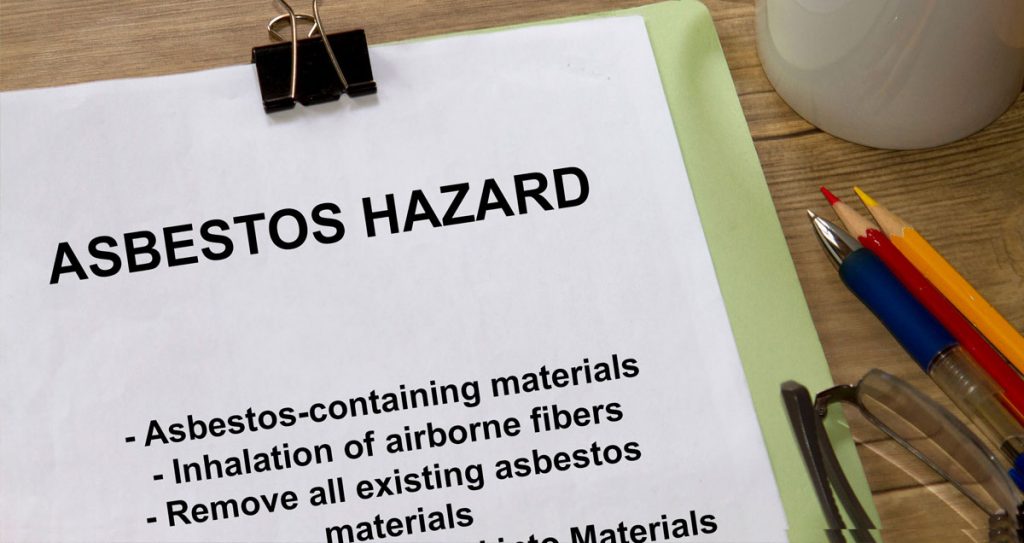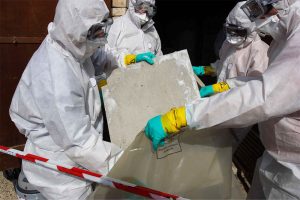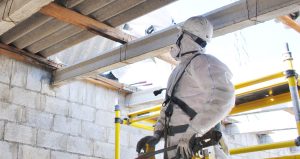Looking for Professional Asbestos Ceiling Removal?
Anyone who’s lived or worked in a property with 1970s décor will be familiar with Artex. It’s a textured surface coating that bears a resemblance to plaster, and is identified by its bold, swirly patterning. The product was originally developed to boost the market for DIY plastering. Its thick consistency was designed for ease of application, and the trademark patterning covered up any mistakes.
The magic ingredient which gave Artex its unique texture was asbestos. In fact, Artex is an acronym for Asbestos Reinforced Textured Coating. The amount of asbestos used in the production of Artex is between 1-4%. This is relatively low, but nevertheless hazardous. The use of asbestos in construction materials was banned in 1999. Artex survives as a brand name to this day, but it no longer uses asbestos in its products.
The Legacy of Asbestos in Homes and Workplaces
Asbestos was widely used for construction purposes throughout the 20th century. It was an effective insulator, in plentiful supply and therefore cost effective, And for these reasons it was a staple of building development. Research into the hazards of asbestos inhalation began in the early 1900s, but it took over 50 years for the findings to be accepted, and a ban followed at the close of the century.
Inhalation of microscopic asbestos fibres can lead to chronic breathing problems, lung cancer and mesothelioma. Unfortunately, it can take decades for the symptoms to emerge, and by then it’s often too late to treat the underlying condition. HSE figures show that there are currently 5,000 asbestos related deaths each year. Many of the victims were exposed to asbestos in the workplace 50 years ago.
Do You Have Artex Ceilings in Your Home or Workplace?
If Artex plastering predates 1999, it’s sensible to presume that your ceiling contains asbestos. There are thousands of extant Artex ceilings, and in many cases they are left untouched. Whilst asbestos remains in an inert state it is safe. It’s only when it’s disturbed or damaged that the dangerous asbestos fibres can become airborne.
Should you wish to remove your Artex ceiling, the first step is to determine whether or not it contains asbestos. An asbestos survey, carried out by HSE licensed asbestos specialists will determine the composition of the plasterwork. If the Artex does contain asbestos, you have a number of options for managing it:
- DIY asbestos removal in a domestic setting is legal, but Avanti experts would strongly recommend licensed asbestos removal, or professionally supervised asbestos removal.
- Asbestos removal in the workplace needs to be carried out by an HSE licensed asbestos removal company, by law.
- Re-plaster over the Artex ceiling. You will, however, need to alert future tenants, or purchasers of the property of the presence of asbestos.
- Plasterboard over the Artex. This safely contains the material but future occupants or buyers will need to be aware of its presence.
An Asbestos Removal Company You Can Rely On
Avanti is an HSE licensed asbestos removals company. We carry out non-intrusive, domestic and commercial asbestos surveys to determine the presence of ACMs (Asbestos Containing Materials). If asbestos ceiling removal is necessary, Avanti specialists will carry out safe removals and disposal. Air monitoring is implemented throughout the process of asbestos removal. This ensures that the environment complies with the ISO17025 standard before Avanti signs off on the removals process.
Are you looking for reliable, professional asbestos ceiling removal? Avanti is an HSE licensed asbestos removals contractor. Call us today on0333 3355974



